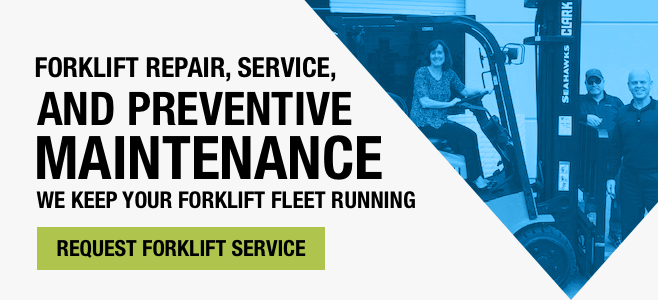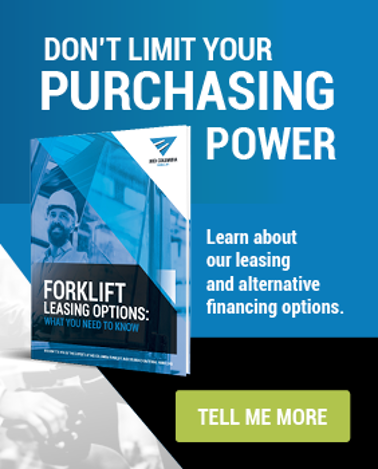Forklift Seatbelts Stand Between Your Warehouse and Disaster
by Enrique Hernandez, on April 21, 2025 at 12:21 PM
 Operating a forklift is a dangerous activity made safer through stringent safety protocols.
Operating a forklift is a dangerous activity made safer through stringent safety protocols.
On average, forklift accidents kill 87 people per year. That number has risen almost continuously in the last decade.
Although forklifts only account for 1% of warehouse accidents, they cause 11% of serious injuries.
In fact, 11% of forklifts in the U.S. are involved in accidents annually. So, if your facility has at least ten, you're almost guaranteed an accident this year. OSHA estimates that 70% of forklift accidents are preventable, meaning you can't prevent every accident. However, you can take steps to lessen the damage. Forklift safety belts are the first and most important precaution you can take to protect the people most at risk—your operators.
Read on to learn why forklift seatbelts are so important and how you can ensure compliance.
Why Are Forklift Safety Belts So Important?
A few years ago, an operator jumped into the cab to move an unloaded forklift out of the middle of the road. He neglected to buckle up since he was only driving 15 feet. However, the road was slick that day.
As he approached the edge of the street, the lift truck slid sideways.
His tires impacted the curb, and the force was enough to tip the truck. The sudden jolt ejected him, tossing him onto the sidewalk. There was no way he could have moved fast enough. The forklift rolled onto him, crushing his skull beneath it. He was dead before the paramedics ever reached him.
Forklift accidents aren’t any more common than other accidents; they’re just more severe.
How Do Forklift Seatbelts Protect Your Operators?
Forklift seatbelts are the most important safety features on the forklift.
 Rollovers account for roughly 50% of all forklift accidents. That's why modern forklifts have rollover protective structures (ROPS). These protect the driver in case of a rollover. However, their effectiveness requires that the operator stays in the driver's seat. Physics and instinct work against the driver during a rollover, conspiring to get them out of the tipping truck and into a place where they are exponentially more likely to get crushed.
Rollovers account for roughly 50% of all forklift accidents. That's why modern forklifts have rollover protective structures (ROPS). These protect the driver in case of a rollover. However, their effectiveness requires that the operator stays in the driver's seat. Physics and instinct work against the driver during a rollover, conspiring to get them out of the tipping truck and into a place where they are exponentially more likely to get crushed.
Forklift seatbelts prevent that.
Their protection is twofold. First, they keep the force of the rollover from throwing the operator out of the seat. Second, they delay an operator’s ability to jump out, preventing instinct from getting them killed. These are simple things, but during a rollover, they are enough to prevent serious injury and death.
Forklift seatbelt safety saves 99.9% percent of lives during a rollover.
What To Do in Case of a Rollover
If the worst happens and one of your operators finds themselves in a rollover, there are three things they can do to stay safe.
- They wear safety belts every time they operate the forklift, no matter how short the journey.
- Ignore the reflex to jump out. It's a coin flip whether an operator will jump out in the correct direction. If they don't, the forklift is likely to crush them.
- Brace themselves. An operator should keep both hands on the steering wheel and use the pressure to brace their upper body. Likewise, they should keep both feet firmly on the floor and press down to brace their lower body. Take every action possible to remain inside the forklift’s ROPS.
Remember, inside the forklift is the safest place to be during a rollover.
How Can You Ensure Safety Belt Compliance?
Despite its importance, safety belt compliance isn’t automatic.
Why Don’t Forklift Operators Wear Seatbelts?
There are many reasons why operators don’t take the time to fasten their safety belts.
Time is a big one. Operators who are working fast and making many short trips often see seatbelts as a waste of precious time. They think they aren’t traveling far enough to need one or that it will only slow them down.
The story at the beginning of this article shows the fallacy of that thinking.
The second reason is comfort. Some operators find forklift safety belts restrictive. They may find wearing a snug lap belt uncomfortable for an extended shift.
Worse, this leads drivers to modify belts, such as knotting or adding padding, which can impair their use.
The final reason is psychological. Drivers feel protected by their forklift, especially in a closed cab. They think of these 9,000 lbs machines as suits of armor and forget that they can be just as dangerous to the operator as pedestrians.
Whatever the reasons for not wearing a safety belt, they pale compared to the dangers avoided by their use.
What Are the Best Practices for Forklift Safety Belt Compliance?
As a warehouse manager, you are responsible for enforcing compliance.
OSHA issues fines for not wearing seatbelts while operating a forklift. These citations don't go to the operator. They go to the employer as the employer is responsible for ensuring a safe working environment.
That means you must stay vigilant. One of the best and easiest ways is to install orange forklift seatbelts. These high-visibility safety belts make it easy to spot operators who aren’t wearing them.
Additionally, it’s useful to have forklift seatbelt extenders for any employee who might need one.
Next, you'll want to ensure seatbelts are part of pre-shift inspections. Have drivers test for function and check for any unauthorized modifications, such as knots that limit how far the belt can retract. If a seatbelt fails inspection, the forklift should be tagged and removed from service until the safety belt is repaired.
Finally, ensure drivers only use seatbelts for their intended purpose and not for things like holding cab doors closed.
Your Forklift Safety Partner
Wearing a forklift safety belt isn't just a good idea; it's the law.
We can help you keep your team safe and avoid costly OSHA fines. Simple fixes like high visibility belts are often enough to make the difference. Let us help you keep your warehouse safe.
To learn more about improving forklift safety and keeping your warehouse OSHA-compliant, contact us online or visit one of our locations.
Auburn 253-854-5438
Pasco 509-547-7413
Wenatchee 509-663-9009
Yakima 509-457-5137
Further Reading
7 Little Accessories That Make a Big Difference in Forklift Safety
Pedestrian Alert System for Your Forklift
Common Forklift Operator Injuries and How to Prevent Them




